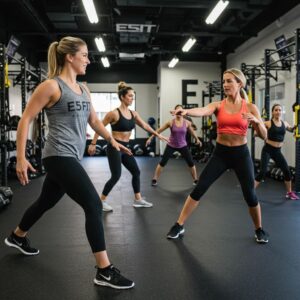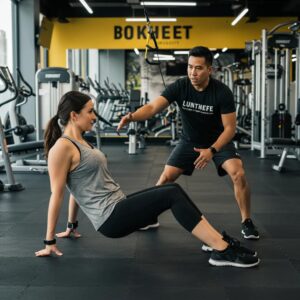Introduction to Personal Training Results
Starting personal training is one of the most empowering decisions you can make for your health and fitness. Whether your goal is to lose weight, gain muscle, feel more confidence, or simply move better, a consistent 3-month training program can yield remarkable changes—physically, mentally, and emotionally.
But why 3 months? Because it strikes the perfect balance between giving your body enough time to adapt and staying short enough to remain focused and motivated. In just 12 weeks, you’ll likely see improvements in body composition, strength training, endurance, flexibility, and overall energy levels. This timeline is also long enough to build meaningful habits and short enough to keep your eye on the prize.
Working with a personal trainer accelerates your progress by providing structure, accountability, and expert guidance. You’re not just guessing at what works—you’re following a personalized plan built around your unique goals, schedule, and fitness level. Plus, having a coach in your corner helps keep you motivated, safe, and consistent, which are the real keys to seeing results.
This article breaks down the top 5 results you can realistically expect after 3 months of personal training. It also explores supporting factors like nutrition, mindset, and progress tracking—giving you a 360-degree look at what success really looks like at this stage. Whether you’re thinking about starting or already a few weeks in, knowing what to expect can help you stay focused, committed, and excited about your fitness journey.
What Makes 3 Months a Transformative Milestone?
Three months isn’t just an arbitrary timeframe—it aligns with your body’s natural adaptation process. After around 8–12 weeks of consistent exercise, your muscles, metabolism, and cardiovascular system begin to noticeably respond. You’re no longer in the “getting started” phase—you’ve developed foundational strength, improved technique, and begun forming sustainable habits. This is the turning point where your initial efforts begin to compound and visible changes start taking shape, both in how you look and feel.
Setting Realistic Expectations with a Personal Trainer
A great personal trainer helps set the tone early: real, lasting change doesn’t happen overnight. They’ll assess your current fitness level, understand your goals, and create a plan that matches your lifestyle. In 3 months, you won’t achieve a bodybuilder physique—but you will likely drop fat, gain lean muscle, and significantly improve strength and endurance. Your trainer keeps expectations grounded in science, not social media myths, ensuring progress is steady, sustainable, and safe. By aligning expectations with effort and consistency, they help you build a foundation for long-term success—not quick fixes.
Improved Body Composition
One of the most visible and motivating results after 3 months of personal training is an improvement in body composition. This refers to the ratio of fat mass to lean mass in your body—not just your weight. With consistent workouts and a supportive nutrition plan, most clients experience a noticeable decrease in body fat and a simultaneous increase in lean muscle. This dual effect makes your body look tighter, more toned, and healthier overall. Even if the scale doesn’t drop significantly, you’ll feel stronger, look leaner, and notice your clothes fitting differently—signs of real transformation.
Reduction in Body Fat Percentage
Reducing body fat is a common goal in personal training programs, and 3 months is a realistic timeframe to see meaningful progress. A structured combination of strength training, cardio, and proper nutrition helps create a calorie deficit, which encourages your body to burn fat for energy. While results vary, many individuals can expect to lose 1–2% body fat per month with consistency, translating to a 3–6% drop over a 90-day period.
This reduction not only improves how your body looks—it also has health benefits like better insulin sensitivity, reduced inflammation, and lower risk for chronic diseases. Your certified personal trainer may use tools like body calipers, InBody scans, or circumference measurements to track changes more accurately than a scale alone.
Importantly, fat loss tends to happen gradually and unevenly, depending on genetics and hormones. You might first notice changes in your face, arms, or waistline before other areas catch up. The key is consistency—not perfection. When training sessions are combined with mindful nutrition and recovery, your body becomes more efficient at using stored fat, resulting in leaner, more defined contours over time.
Increase in Lean Muscle Mass
Building lean muscle isn’t just for aesthetics—it’s essential for boosting metabolism, supporting joint and bone health, and improving everyday strength. After 3 months of progressive strength training, you can expect modest but meaningful muscle gains, especially if you’re newer to lifting. For beginners, it’s common to gain 1–3 pounds of lean muscle during this period.
Muscle growth, or hypertrophy, is triggered when you challenge your body through exercise. Under the guidance of a certified personal trainer, workouts are strategically designed to target all major muscle groups with proper intensity, volume, and rest intervals. This promotes micro-tears in muscle fibers, which repair and grow back stronger.
Your trainer might track performance metrics and body composition over time, helping you see the lean muscle you’re adding, even if the scale stays the same. With the right combination of strength training, adequate nutrition intake, and recovery, these early gains lay the foundation for long-term fitness progress.
Changes You’ll See in the Mirror vs the Scale
One of the most important mindset shifts in personal training is learning that the scale doesn’t tell the whole story. Many clients become frustrated when the number on the scale barely moves, but that doesn’t mean progress isn’t happening. In fact, you might be gaining lean muscle at the same rate you’re losing fat—making your weight appear static, even though your body is transforming.
The mirror, your clothes, and how you feel are often better indicators. Your waist may shrink, your arms may look more defined, and your posture may improve—visible changes that a scale can’t capture. Muscle takes up less space than fat, so even at the same weight, your body may appear noticeably leaner and more toned.
Progress photos and measurements are excellent tools your trainer may use to track your transformation. These give a clearer picture of what’s happening beneath the surface and help you stay motivated when the scale seems stubborn.
In the end, it’s about body recomposition—the process of reducing fat and building muscle at the same time. Emphasizing visual and physical improvements over scale weight helps reinforce a healthier, more sustainable relationship with fitness, confidence, and body image.
Enhanced Strength and Performance
After three months of consistent exercise in your personal training program, one of the most rewarding outcomes is increased strength and physical performance. Whether you’re lifting heavier weights, doing more reps, or moving with greater control, these gains are tangible and motivating. Strength training improvements aren’t just limited to the gym—they also reduce the risk of daily discomfort and make activities like climbing stairs or lifting groceries feel easier. You’ll feel empowered in every training session, knowing your muscles and bones are becoming more resilient.
Strength Gains Through Progressive Overload
Strength gains come from applying the principle of progressive overload—strategically increasing resistance, volume, or frequency to challenge the body. This approach, guided by your certified personal trainer, ensures that your body doesn’t stagnate but continues to grow. You’ll likely see dramatic improvements in functional lifts, posture, and fitness performance. Apps and tools within your personal training studio may be used to track your reps and loads, providing clear visual feedback that enables growth. Every rep is a new pass to a stronger you.
Your trainer will monitor your form, track your performance, and adjust your program to prevent plateaus. Progress might look like deadlifting 50% more than when you started, holding a plank twice as long, or finally nailing a bodyweight push-up. These improvements boost confidence and keep motivation high.
Progressive overload also prevents boredom and encourages consistent engagement. As you master new challenges, your body continues to evolve—keeping your journey dynamic and goal-oriented.
Real-Life Functional Strength Improvements
Functional strength is all about applying what you gain from the gym to real life. You’ll notice how your group fitness classes, home workouts, or even weekend sports feel easier. Your personal trainer will use a variety of movement patterns that simulate real tasks. With increased mobility, you’ll reduce the risk of injury and enhance your energy and efficiency. These changes are empowering and increase your confidence in both the gym and everyday life.
Key Metrics Trainers Use to Measure Strength Progress
In your training sessions, several performance indicators help evaluate your improvements: max lifts, time-based holds, or endurance in bodyweight exercises. Your personal trainer may use apps or SMS-based check-ins for accountability and progress updates. Metrics help ensure the program remains tailored, secure, and effective. This system of monitoring gives both information and motivation to keep improving, while maintaining the security of proper form and recovery protocols.
Common metrics include:
- One-rep max (1RM) estimations for key lifts like the squat, bench press, or deadlift.
- Repetition maxes (e.g., how many push-ups you can do in a row or how much weight you can lift for 8–12 reps).
- Time-based tests, such as how long you can hold a plank or wall sit.
- Bodyweight exercise benchmarks, such as mastering a full push-up, pull-up, or unassisted squat.
Trainers may also track progress photos, volume loads (sets × reps × weight), and even your rate of perceived exertion (RPE) to ensure your workouts are appropriately challenging.
These metrics not only help trainers fine-tune your program but also keep you motivated. Seeing that you’ve gone from squatting 60 pounds to 100 pounds or doubling your push-up count builds confidence and momentum. Regular assessments ensure your plan evolves with you and keeps delivering results.
Increased Cardiovascular Fitness
As your heart and lungs adapt through regular exercise, your fitness level and energy increase significantly. A combination of LISS and HIIT cardio, often offered in small group training or group fitness settings, helps build endurance. Your personal training plan ensures cardio is not only effective but enjoyable and sustainable, especially with the structure offered in your fitness journey.
How Cardio Conditioning Evolves Over Time
Over time, your cardiovascular system becomes more efficient at circulating oxygen. This supports longer, more intense training sessions and better recovery. You’ll notice your resting heart rate drops and you recover more quickly between sets. These changes may be tracked via your app or by your certified personal trainer, helping you stay motivated and informed.
Impact on Resting Heart Rate and VO2 Max
Improvements in VO₂ max and resting heart rate are vital signs of growing fitness. With each pass through a session, you improve heart health, burn more fat, and expand aerobic capacity. It’s not just about looks—your internal systems are working smarter. These metrics are powerful for setting goals and providing accessibility to your performance growth.
Everyday Benefits: Stamina, Endurance & Recovery
With better cardiovascular health, your stamina extends beyond the gym. You can walk farther, handle workdays with more focus, and even sleep more soundly. Your barre class, your group fitness classes, or your walks with family become easier. The compounding effect of regular exercise delivers energy and productivity across all areas of life.
Better Mobility and Flexibility
Three months of focused personal training can unlock tight hips, shoulders, and spines. Your trainer will guide you through warmups and cooldowns that improve joint function and support injury prevention. The emphasis on mobility and flexibility also improves form during strength training, reducing risk and increasing accessibility for advanced movements.
Reduced Joint Stiffness and Pain
Many clients experience reduced joint pain within weeks. Techniques like foam rolling, mobility drills, and supported stretches target common problem areas. Whether you’re in a one-on-one session or a small group training environment, these movements support both bone health and tissue resilience. Trainers may enable more customized routines with the help of a fitness app or program.
By incorporating movement into all planes (not just forward and backward), your joints get more exposure to their full range of motion. This improves synovial fluid circulation, which lubricates joints and reduces stiffness. You’ll likely notice reduced tension in common tight zones like the hips, lower back, and shoulders.
Exercises like deep squats, dynamic stretches, foam rolling, and yoga-inspired mobility flows help you move more freely and with less pain. Many clients report being able to sit, stand, and walk with greater ease—and experience fewer flare-ups from past injuries or chronic discomfort.
Improved joint mobility not only makes workouts more effective but also enhances daily living. From tying your shoes to reaching overhead comfortably, this functional freedom is one of the most underrated but rewarding results of personal training.
Increased Range of Motion in Key Areas
With consistent work, you’ll notice a smoother gait, deeper squats, and better shoulder movement. Your personal trainer may use barre-inspired movements or resistance bands to improve control. This increases the effectiveness and safety of your strength training while enhancing how you feel throughout your day.
Why Trainers Prioritize Mobility Alongside Strength
Mobility isn’t optional—it’s foundational. A tight hamstring or stiff hip can limit your progress and increase injury risk. Integrating mobility ensures longevity, sustainability, and progression. Whether in your one-on-one or group fitness settings, your trainer will make sure mobility and strength support each other so you can continue training with confidence.
Boost in Mental Health and Confidence
Aside from physical gains, the emotional benefits of exercise and personal training are profound. Many report improvements in mood, mental clarity, and reduced anxiety. Just showing up for your fitness journey builds momentum, and hearing encouragement in your training sessions reinforces self-belief and confidence.
How Exercise Reduces Stress and Anxiety
Exercise helps manage cortisol, improves sleep, and releases endorphins. This chemical balance reduces tension and boosts your resilience. Structured workouts—whether solo or in group fitness classes—offer predictable relief. With enabled scheduling features via app or sms, consistency becomes automatic, reducing emotional decision fatigue.
The Confidence That Comes from Consistency
There’s power in repetition. Each rep, each session, reinforces your confidence and self-image. Reaching milestones like weight goals or mastering movements builds your mental security and sets you up for success in other areas—work, family, or self-expression. Whether it’s learning how to get better at pull-ups or finally conquering a wall sit, each success reinforces the belief: “I can do this.”
Mental Resilience from Physical Discipline
Discipline in training feeds discipline in life. You begin to see challenges not as threats, but opportunities. Your routine creates structure, your results create confidence, and the ability to continue through tough weeks reinforces emotional durability. These are skills you don’t just build in the gym—you bring them everywhere.
Common Challenges in the First 90 Days
The honeymoon phase fades—plateaus, soreness, or fatigue set in. Life gets busy, and motivation may dip. This is where the pass to growth comes from perseverance. A good certified personal trainer adjusts your program, makes things fun again with varied training sessions, and helps you reset focus—whether that’s adding battle ropes workouts or trying new squat alternatives to keep things engaging.
How to Sustain Your Gains After 3 Months
The 90-day mark is your launchpad. Now it’s time to set new goals: whether it’s adding muscle, joining a group fitness class, or increasing your running distance. You might shift from fat loss to muscle definition or try a new exclusive studio program. Keep the momentum going with progressive challenges, goal reassessments, and coaching support.
This means continuing to train consistently, but with renewed goals. Instead of just fat loss or strength gains, you may now focus on skill-building, performance milestones, or muscle definition. This is what we call building toward long-term fitness goals—and it’s where real transformation takes off.
A personal trainer will help you reflect on what’s worked, where you’ve improved, and what needs tweaking. You’ll also begin transitioning to intermediate or advanced programs, with more complex movements, heavier loads, or different training splits. This keeps workouts engaging and progress steady.
Nutrition also needs to grow with your training. You may shift from a calorie deficit to maintenance or muscle-building mode, depending on your goals. You might even adopt principles from the Blue Zone diet to improve longevity and recovery. The key is to avoid the “yo-yo effect” of stopping once you’ve made progress weight loss.
The 90-day point is not the finish line—it’s the launch pad. By staying accountable and goal-focused, you not only maintain your gains—you amplify them.
Conclusion: Why 3 Months is Just the Beginning
You’ve made real progress—now comes the fun part. With a strong foundation, you can explore new areas: barre, mobility circuits, performance training. Continue using the information you’ve gathered from your metrics and coaching feedback to build a long-term, fulfilling fitness journey.
Motivation will fluctuate, but systems keep you on track. Leverage your app, check in via sms, or lean into the community of your group fitness environment. With every win, your internal identity shifts from “trying” to “doing.”
Celebrate your success, but don’t stop setting goals. Reflect on what you’ve learned and how far you’ve come—physically, mentally, and emotionally. Use that as fuel to push forward. Revisit your “why,” whether it’s to be stronger for your family, feel confident in your body, or simply live pain-free.
Working with your trainer to create new goals is key. Whether it’s mastering your first pull-up, training for a 5K, or hitting a personal lifting record, new challenges create fresh purpose. You might also explore new modalities like kettlebell training, mobility flows, or athletic conditioning finishers to keep workouts exciting.
Consistency and curiosity will carry you farther than motivation alone. Some weeks will feel effortless, others will feel hard—but showing up anyway is what makes you unstoppable. The journey doesn’t end at 3 months—it just changes shape.
Track new PRs, mobility gains, or consistency streaks. Upgrade your app features or switch to an advanced program. Try a new challenge pass, join a specialized personal training studio, or aim to help someone else start their own fitness journey. You’re not just building a body—you’re shaping a lifestyle.
Beyond physical benchmarks, consider lifestyle wins like hitting 10,000 steps a day, drinking a gallon of water daily, or cooking more meals at home. These habits deepen your foundation and create ripple effects across your life.
Your trainer will likely retest your initial metrics—weight, measurements, strength scores, and cardio performance—to track how far you’ve come. Use these data points to shape your next 3-month plan.
Goal setting should be dynamic, not static. As you get stronger, your goals should too. That might mean longer sessions, harder challenges, or new areas of focus like mobility, agility, or sport-specific training. The goal isn’t to stay the same—it’s to continually redefine what success looks like.
Progress is a moving target. But with the systems you’ve built and the confidence you’ve earned, you’re now equipped to chase it with clarity, purpose, and passion.



